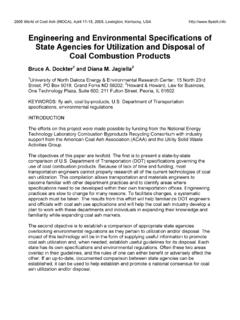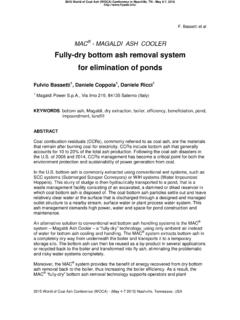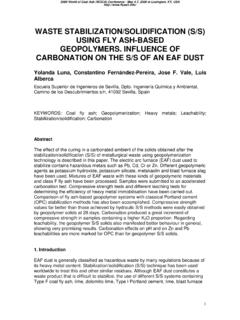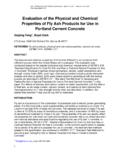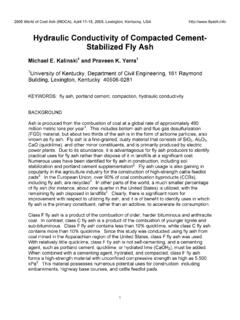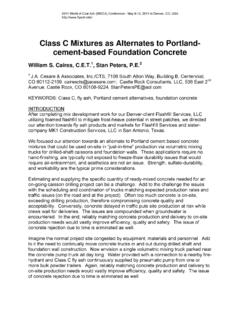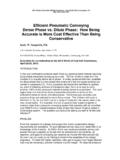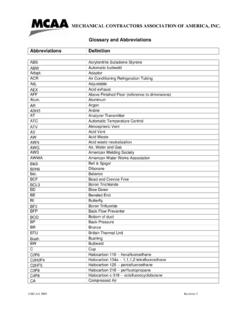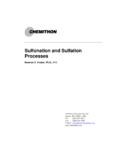Transcription of The Growth of Dry Sorbent Injection (DSI) and the …
1 2013 World of Coal Ash (WOCA) Conference - April 22-25, 2013 in Lexington, KY. The Growth of Dry Sorbent Injection (DSI) and the impact on Coal combustion Residue Michael D. Schantz1, Melissa Sewell2. 1. Director Flue Gas Treatment Solutions, Lhoist North america , 3700 Hulen Street, Fort Worth, TX 76132, 2 Manager Flue Gas Treatment Solutions, Lhoist North america , 3700. Hulen Street, Fort Worth, TX 76132. KEYWORDS: Dry Sorbent Injection , DSI, calcium hydroxide, hydrated lime, trona, SO3, HCl INTRODUCTION. Dry Sorbent Injection (DSI) refers to the practice of injecting a dry alkaline mineral into a flue gas stream in an effort to capture acid gases. The use of this technology at utilities and industries is expanding rapidly as a low capital cost solution for compliance with evolving environmental control requirements. This paper discusses the drivers for the use of DSI technology and the potential impacts of the DSI reagents on the Coal combustion Residue (CCR), whether disposed or marketed.
2 THE DRIVERS FOR DRY Sorbent Injection (DSI). DSI technology was evaluated as a potential acid gas control technology as early as the 1980's, however as a general rule, capture efficiencies were not high enough to address the removals required at utility coal-fired boilers under Phase One SO2 control requirements of the 1990 Clean Air Act Amendments. However, advances in Sorbent effectiveness, combined with new regulatory drivers, have DSI playing a major role in utility and industry compliance strategies. Much of the recent rebirth of DSI technology was driven by the unintended consequence of installing SCR technology on coal-fired utility boilers combusting high sulfur fuel. Unfortunately retrofitted SCR systems designed to capture NOx also convert some percentage of SO2 to SO3. This SO3 has become a major issue for many utilities as the SO3 reacts with moisture in the flue gas and atmosphere as the gas cools.
3 This has resulted in localized H2SO4 emissions or so called blue plume issues. Over the last ten years, DSI with both calcium and sodium products have proven effective for control of SO3 emissions and are in use at dozens of facilities today. Three additional rule making efforts aimed at coal-fired utilities are expanding the interest in DSI technology. Perhaps most significant is the implementation of the utility MATS rule, which requires control of HCl emissions from coal-fired power plants for the first time. In fact, the EPA has estimated that 62 GW of coal-fired utilities will utilize DSI technology to comply with the recently finalized utility MATS rule. While the validity of this estimate is certainly debatable, the use of DSI technology at coal-fired plants is clearly growing. Also impacting the interest in DSI technology is the reemergence of the regional haze rule making efforts and reimplementation of CAIR as a result of the vacature of the Cross State Air Pollution Rule (CSAPR).
4 All of these rules will require coal-fired units that do not have acid gas scrubbers installed to evaluate their options for controlling acid gases including SO2, HCl and higher levels of SO3. It is also clear that controlling these acid gases will require utilization of much higher amounts of DSI reagent than that already experienced for basic SO3 control. It is these higher levels of DSI reagents that have the potential to dramatically impact the properties of the CCR from a given facility. BASIC CHEMISTRY OF DSI REAGENTS. The chemistry associated with DSI technology is relatively straight forward and well understood at this point. The two primary chemistries being utilized for utility acid gas control with DSI are calcium based and sodium based. The primary calcium reagent being widely utilized is hydrated lime or calcium hydroxide (Ca(OH)2) and the basic reactions that result in the capture of SO2 and HCl are outlined below.
5 Ca(OH)2 + SO2+ .5O2 CaSO4 + H2O. Ca(OH)2 + 2 HCl CaCl2 + 2H2O. Accordingly, the primary reaction products of calcium based DSI are calcium sulfate and calcium chloride. Given the relative volume of sulfur compounds vs. the lower concentration of chlorides in a typical flue gas stream there is generally quite a bit more of the sulfate reaction products than chloride reaction products present. Note that there are other less critical reaction products resulting from interaction with Hydroflouric acid and even CO2 in the flue gas, but the primary reaction products are those associated with sulfates and chlorides. The sodium based chemistry is a bit more complex in that both trona (sodium sesquicarbonate) and sodium bicarbonate can be used in sodium based DSI. applications. However, the reaction products are ultimately the same for either compound. The basic trona reaction for sulfate capture is outlined below[1].
6 2(Na2CO3 NaHCO3 H2O) + 3SO2 3Na2SO3 + 4CO2 + 5H2O. Secondary sulfate capture reaction is as follows: 3Na2SO3 + 3Na2SO4. The basic chloride capture mechanism for sodium reagents is as follows [1]: Na2CO3 NaHCO3 H2O + 3 HCl 3 NaCl + 2CO2 + 4H2O. In the case of the sodium chemistry the primary reaction products are sodium sulfate and sodium chloride. Just as with calcium, there is generally much more of the sulfate reaction product than the chloride reaction product due to the relative concentration of the pollutants in a coal-fired utility typical fuel gas. FACTORS THAT impact DSI SYSTEM EFFECTIVENESS. DSI is being employed for a wide variety of acid gas control applications. At unscrubbed utilities, DSI technology is being employed for primary SO2 control as well as a viable approach for HCl compliance for the MATS rule. At scrubbed utility units, DSI technology is generally employed for SO3 control.
7 However, there is a growing population of facilities using DSI technology to remove chlorides from the scrubber chemistry and minimize the use of activated carbon for mercury control. Regardless of the specific application, the effectiveness of a DSI system is a function of the three broad categories of factors listed below: Flue Gas Properties Temperature, flue gas moisture and other competing acid gases (SO3, HCl, HF and SO2). Reagent Properties inherent reagent reactivity, reagent surface area, reagent porosity, pore geometry Injection System Configuration - Particulate control device, in flight residence time, reagent mixing and Injection location In addition to impacting the effectiveness of a DSI system for a given control requirement, the impacts of a DSI system on the CCRs are influenced by these factors as well. While the use of DSI reagents at utilities using wet scrubbers for SO2.
8 Compliance will clearly impact the scrubber sludge, this presentation will focus primarily on the impacts to the fly ash, whether marketed or disposed. Injection SYSTEM CONFIGURATION IMPACTS. ESP. Air Heater Scrubber Figure One Clearly the selection of where a DSI reagent is introduced will have differing impacts on the CCR materials. The current trend on employing DSI systems is to move the system further back towards the boiler in an effort to gain the benefits of removing the acid gases earlier in the post combustion control system. The major benefits that are being realized from this approach are related to 1) removing SO3 prior to the air heater, thereby reducing the potential for ammonia bisulfate formation in the air heater and 2). removing the SO3 in advance of activated carbon Injection (ACI) to improve the performance of the carbon for mercury capture. However, an Injection of a DSI reagent prior to the particulate control system will inevitably result in impacts on the CCRs.
9 If maintaining the marketability of a fly ash stream is a priority for a given plant, it may be possible to install a DSI system allowing for Injection of the reagent immediately after the existing particulate collection system. However, while this approach will mitigate impacts on the fly ash, there are significant trade-offs. The first issue is that if the existing wet FGD system can not handle the additional particulate loading associated with the DSI reaction products, a secondary particulate collection device dedicated to the capture of the DSI reaction products would have to be retrofitted. Alternatively, the wet FGD system may be capable of handling the additional particulate loading resulting from the DSI reagent. In this instance, the use of Ca(OH)2 results in sulfate reaction products that are the same as those for the FGD scrubber itself, namely CaSO4. Use of sodium based reagents would result in sulfate reaction products that are inconsistent with the marketing of the FGD process synthetic gypsum and therefore require additional processing or disposal of the scrubber sludge.
10 An additional issue with the approach of injecting post existing particulate collection system, and relying on the FGD system for DSI reaction product capture, is that the reagent will be less effective due to reduced residence time. This would result in higher reagent consumption for a given level of acid gas control. REAGENT REACTIVITY CONSIDERATIONS. Regardless of how the DSI system is configured, the reactivity of the DSI reagent will determine how significant an impact a DSI reagent will have on the fly ash stream. As an example, if a higher reactivity Sorbent (whether sodium or calcium) is used, less unreacted Sorbent will be present in the CCR stream. In the case of a calcium sorbents, the reactivity of a reagent is primarily a function of the calcium hydroxide surface area, pore volume and pore geometry. This means that a calcium hydroxide optimized for acid gas capture will require less reagent for a given level of control and therefore would result in less unreacted Ca(OH)2 in the residue.
